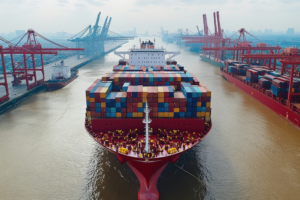The ongoing trade tensions between the United States and China have escalated once again, reigniting concerns across global supply chains. From tariffs and sanctions to export restrictions and reshoring initiatives, the current phase of the trade war is reshaping how goods are produced, moved, and consumed around the world.
What’s Happening Now?
As of early 2025, the US has introduced new tariffs on select Chinese goods, citing concerns over technology theft, human rights, and unfair trade practices. China, in response, has implemented its own retaliatory measures, including restrictions on rare earth exports and increased scrutiny on American firms operating in Chinese markets.
Beyond tariffs, both nations are ramping up investment in self-sufficiency. The US is pushing forward with the CHIPS and Science Act to boost domestic semiconductor production, while China is doubling down on its Made in China 2025 strategy, aiming to reduce reliance on Western technology.
How It’s Disrupting Global Supply Chains
-
Diversification of Manufacturing Hubs
Many multinational corporations are accelerating their China+1 strategies—shifting portions of their production to countries like Vietnam, India, and Mexico. While this adds resilience, it also brings new logistical and regulatory complexities. -
Rising Costs and Delays
Tariffs are increasing the cost of imported goods, which often trickles down to consumers. Logistics delays caused by shifting routes, customs inspections, and geopolitical uncertainty are compounding the challenge, particularly for industries like electronics, automotive, and pharmaceuticals. -
Reshoring and Nearshoring Trends
In an effort to minimize risk, some companies are moving production closer to home. While reshoring may offer long-term stability, in the short term it often requires significant capital investment, workforce development, and infrastructure upgrades. -
Technology Restrictions and Innovation Slowdown
Export controls on critical technologies (like semiconductors and AI-related hardware) are forcing companies to rethink cross-border R&D collaboration. This not only slows innovation but also creates fragmented ecosystems in areas like telecom and green energy. -
Supplier Visibility is More Crucial Than Ever
Companies with limited insight into their tier-2 and tier-3 suppliers are at higher risk of disruption. The trade war has exposed how deeply interconnected global supply chains are—and how important it is to have real-time visibility, scenario planning, and agile sourcing strategies.
What Businesses Can Do Now
-
Invest in Supply Chain Visibility Tools
Platforms like Lighthouse (yes, a perfect time to plug in) help organizations gain real-time insight into the movement of goods, identify bottlenecks, and make proactive decisions in response to geopolitical shifts. -
Strengthen Supplier Relationships and Contracts
Having diversified, vetted suppliers—and the right contractual levers—can mitigate risks when countries impose sudden trade restrictions. -
Stay Informed and Flexible
Regularly monitoring trade policies, tariffs, and geopolitical developments is essential. Companies that remain flexible in production and logistics planning will fare better in uncertain times.
The US-China trade war isn’t just a bilateral issue—it’s a global disruption with far-reaching consequences. While the challenges are significant, they also present an opportunity for businesses to build more resilient, intelligent, and transparent supply chains. As the landscape continues to evolve, staying ahead will depend on how quickly companies can adapt, diversify, and gain visibility across their operations.









